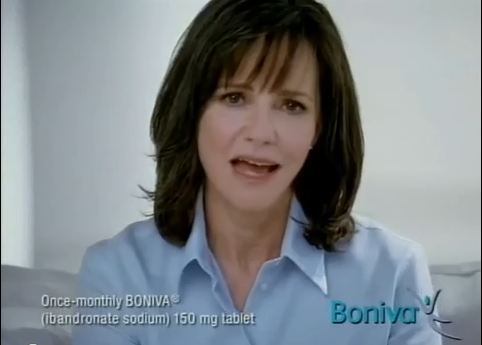Sally Field’s winsome smile may have helped to curb declining sales of Roche’s Boniva in 2010, but it didn’t carry the drug past Warner Chilcott’s Actonel, despite a substantially higher DTC spend.
For a 12-month period ending October 2010, Roche spent $73 million on direct-to-consumer (DTC) ads for Boniva – excluding online DTC – while Warner Chilcott spent $24 million on offline DTC, in support of Actonel, according to SDI Health data. During the same period, Actonel spent $29,000 on medical journals, and Boniva eliminated medical journal spending entirely, according to SDI.
Both drugs are bisphosphonates, and both have taken a hit from generic versions of Merck’s Fosamax (alendronate); generic Fosamax became available in 2008. Actonel, however, is in the final stages of its patent life, while Boniva, by some estimates, still has a few years to go. Novartis’ Reclast, a once-yearly infused bisphosphonate, was the second largest offline DTC spender ($46 million) for the same 12-month period last year, and had US sales of just over $5 million, according to SDI data. Novartis reported combined worldwide sales of $579 million for Reclast and Aclasta, for the 2010 calendar year. Actonel products had sales nearing $600 million, and Boniva sales were $489 million for the 12-month period ending in October, according to SDI Health data.
Excepting Boniva (ibandronate sodium) and Lilly’s Evista (raloxifene, not a bisphosphonate), every brand drug in the osteoporosis category decreased traditional DTC spending in 2010. Actonel’s offline DTC budget was slashed by 63% in 2010, from $65 million in 2009 to $24 million, for matching 12-month periods ending in October. Novartis cut Reclast’s DTC spend by 27% over the same period, from $63 million to $43 million. Boniva marketers, on the other hand, trimmed offline DTC budgets by only 4%, bringing spending down from $76 million to $73 million.
“It helps when you have a face for the product,” said Beverley Tracewell, program director at American Bone Health, a non-profit organization, responding to a question about the prevalence of Boniva’s ongoing Sally Field campaign. Tracewell said televised DTC ads “absolutely” help inform consumers about osteoporosis treatments, and “marketing departments are good at deciding [which media channels] are most appropriate.” A magazine ad starring Field provoked a DDMAC letter in January. A spokesperson at Roche-owned Genentech, makers of Boniva, declined to comment for this article
Tracewell said Lilly’s Evista is “not quite as powerful” as the bisphosphonates for preventing bone loss – Evista mimics estrogen, which starts to decrease during menopause – but the drug has an added indication for reducing the risk of breast cancer. Evista marketers increased offline DTC spend by over 400% from 2009 to 2010, spending $4.8 million in the 12-month period ending in October 2009, and $19.7 million for the same period in 2010, according to SDI.
Tammy Hull, communications manager, bio-medicines at Lilly, said the company has recently ceased televised DTC for Evista. “We were out there talking to everybody, but not everybody needed to hear us,” said Hull. “We found that we could do a much better job of reaching the patients that we really want to talk to, by doing more targeted marketing and advertising.” Hull said the brand is still doing print and online DTC, but will not advertise Evista on television this year.
Sales across the entire osteoporosis category – for the 12-month period ending in October 2010 – were down nearly 14%, to $2.26 billion, from $2.62 billion for the same period a year earlier. Warner Chilcott picked up Actonel (risedronate sodium) marketing rights from Sanofi-Aventis last April, and the company received FDA approval on a next-generation version of the drug – Atelvia (risedronate sodium) – last October. Atelvia contains the same active ingredient as Actonel, but has a new, delayed-release delivery mechanism. Actonel is expected to face generic competition next year.







